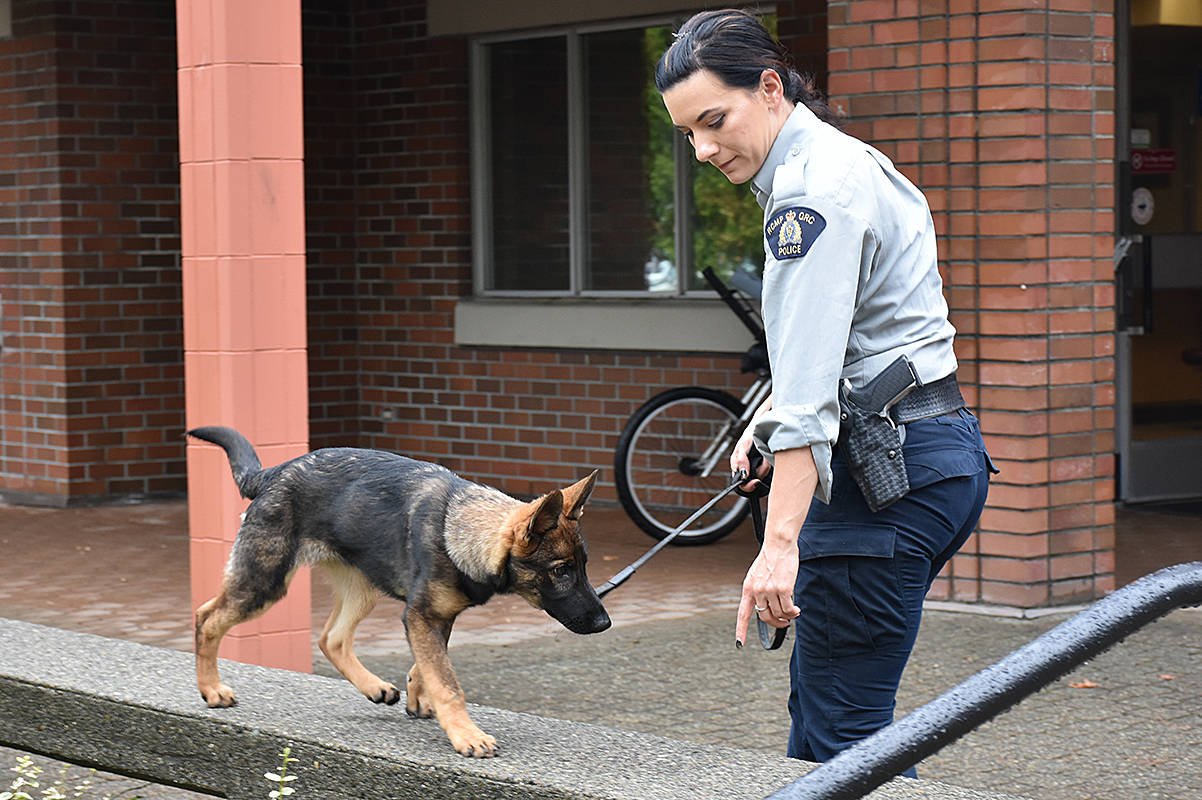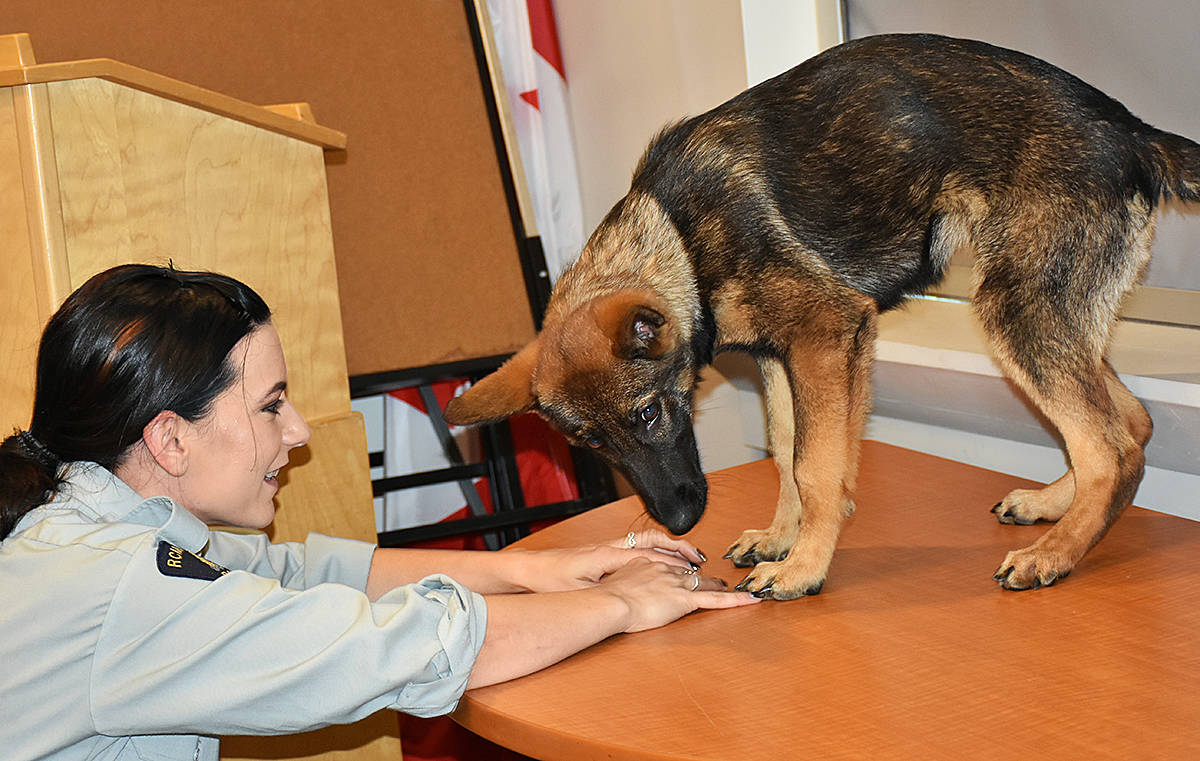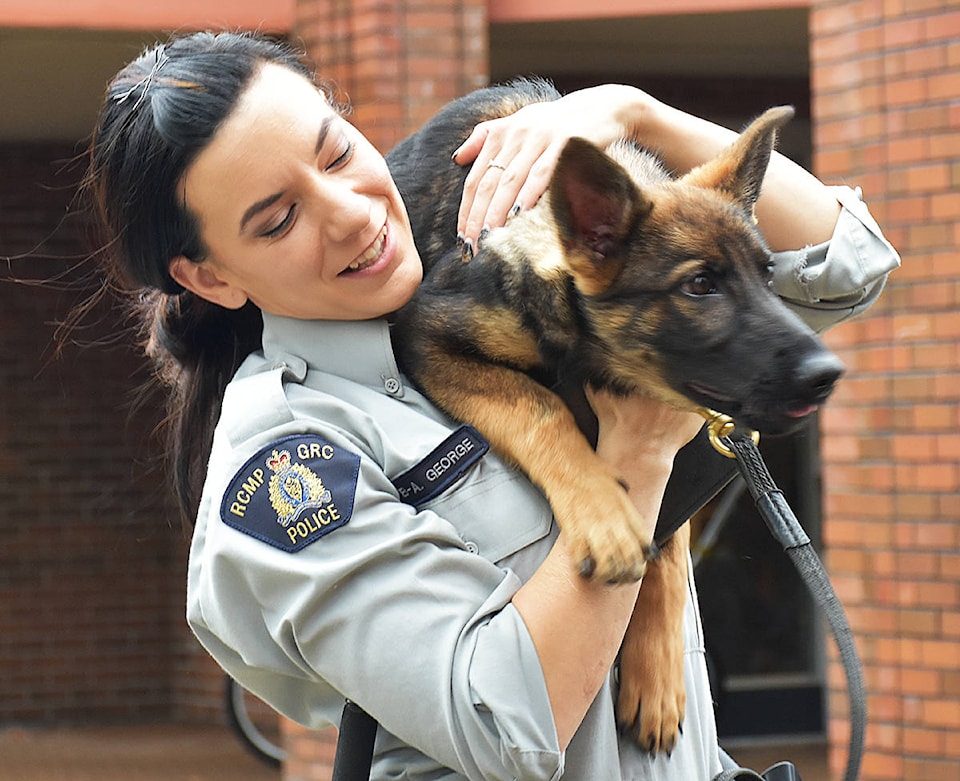Training a police dog puppy looks like a lot of fun.
Ridge Meadows RCMP Const. Britteny George grabs four-month-old Libby, puts her on top of a boardroom table, gets her to follow a trail of treats, then celebrates with a demonstrative arms-in-the-air gesture and an “Atta dog.”
When her training is all done, at about 18 months to two years, Libby will be a no-nonsense police dog who will track suspects through all kinds of situations, while ignoring all distractions, such as other dogs yapping at them – if she makes the grade.
George is also in training. Her career goal is to become an RCMP dog handler. Before she can do that she has to “tag along” with a working dog handler for at least a year, on her own time, to learn the ropes. The amount of voluntary time put into the program is significant, so those who start must love the work.
“I do love it, it’s an amazing program, and it’s a privilege to be part of it,” she said. “It’s being able to dedicate myself into a specific part of the RCMP that has very unique training, and it requires a different set of skills.”
Const. Scott MacLeod is a veteran dog handler, and his service dog Argo is a big shepherd with a good career. He’s got about a year of service left before retirement. One ear droops forward these days, but it doesn’t make him look any less serious.
MacLeod is with the integrated police dog services team in the Lower Mainland.
Every dog handler gives a lot of their time to the work. That time is actually what makes a good dog handler, he said.
“Dedication would be the biggest thing. You’re with that dog 24/7,” he added.
“It’s not just a working tool you can use four to five days a week. The dog is with you all the time, during days off, with your family… it’s a lifetime commitment.”
Imprinters, like George, train puppies starting from seven weeks. They need to hit specified standards at various ages, and are monitored by RCMP dog handlers. They evaluate the imprinters and the dogs.
Libby is just four months old, and has been evaluated for her socialization with people and familiarization.
“The biggest thing with puppies is are they comfortable in buildings, and on slippery floors, stairs, jumping up on small obstacles – that’s essential for a police dog,” MacLeod said.
Ultimately a police dog, if chosen, will get paired with a working handler, who will complete its training.
George said Libby is making the cut so far.
“She’s great. She has a lot of character and a lot of energy,” she said. “Obviously time will tell, but she’s doing well in the program so far.”
“I do socialization and familiarization, so I’ll socialize her with different types of animals. In familiarization, I take her through as many different types of buildings and surroundings as I can find.
“My goal, at the end of the day, is to make sure she can be put in a scenario or situation with her future handler – if she makes it – and be able to have the courage to do what’s asked of her.”
George makes the training fun, keeps the dog engaged, but said the end goal is “to see if she has what it takes to be a police dog.”
One of the main tasks of these dogs is tracking suspects. That’s the “bread and butter” of dogs and handlers.
They are also trained in evidence searching.
“Say if we went to a scene, and the officer on scene says ‘we think we’re missing a knife,’ we will get our dogs out, and our dogs are trained to locate human scent,” said MacLeod. “So if that knife has any human scent on it, they will locate it.”
Finding missing persons, locating firearms, and in criminal apprehension are also tasks the dogs are used for.
After seven years, he is still surprised by Argo’s ability.
“I still go to calls and he will find people and track through areas where I just don’t think there’s going to be a track left,” he said. “But I get back to the truck and think ‘That’s why they have us – that’s why they have police dogs.”
He said the dog has to trust the handler.
“You have to establish that bond, and that’s one of the reasons we use German Shepherds – they’re a very loyal dog.”
“They’re loyal, they work great in all conditions and are very adaptable to their climate, they’re an extremely high energy dog, they’re smart – they’re able to make decisions.”
Once trained, the Shepherds live for tracking and other police work.
“They live to work. When I get my guy in the truck, his tail just starts slapping against the metal cage,” he said.
“When he’s in his kennel at home, he just lays there and waits. Waits to go to work.”
If George becomes a dog handler, she will be assigned wherever there is a need. The same is true for Libby.
The RCMP owns the dogs, but most of the time they will be signed over to the handler at retirement, and the handler will look after the dog for its remaining years, said MacLeod.
“You don’t always have to keep it, but a lot of guys prefer to, just because of the bond they have with the animal.”


